Abstract
In this paper, we investigate a class of ciphers which can be described as a generalized Feistel scheme. Using the graph theory and the number theory, we provide upper and lower bounds for the maximum number of rounds when impossible differential technique is applicable for any cipher from the family. These estimations do not depend on the type of Feistel scheme and the number of non-linear functions.
Access this chapter
Tax calculation will be finalised at checkout
Purchases are for personal use only
Preview
Unable to display preview. Download preview PDF.
References
Biham, E., Biryukov, A., Shamir, A.: Cryptanalysis of Skipjack reduced to 31 rounds using impossible differentials. In: Stern, J. (ed.) EUROCRYPT 1999. LNCS, vol. 1592, pp. 12–23. Springer, Heidelberg (1999)
Knudsen, L.R.: DEAL a 128-bit block cipher. Technical report 151, Department of Informatics, University of Bergen, Norway (February 1998)
Knudsen, L.R.: Truncated and High Order Differentials. In: Preneel, B. (ed.) FSE 1994. LNCS, vol. 1008, pp. 196–211. Springer, Heidelberg (1995)
Feistel, H., Notz, W., Smith, J.L.: Some cryptographic techniques for machine-to-machine data communications. Proc. IEEE 63(11), 1545–1554 (1975)
Schnorr, C.P.: On the construction of a random number generator and random function generators. In: Günther, C.G. (ed.) EUROCRYPT 1988. LNCS, vol. 330, pp. 225–232. Springer, Heidelberg (1988)
Zheng, Y., Matsumoto, T., Imai, H.: On the Construction of Block Ciphers Provably Secure and Not Relying on Any Unproved Hypotheses. In: Brassard, G. (ed.) CRYPTO 1989. LNCS, vol. 435, pp. 461–480. Springer, Heidelberg (1990)
Nyberg, K.: Generlized Feistel networks. In: Kim, K.-C., Matsumoto, T. (eds.) ASIACRYPT 1996. LNCS, vol. 1163, pp. 91–104. Springer, Heidelberg (1996)
Schneier, B., Kelsey, J.: Unbalanced Feistel Networks and Block Cipher Design. In: Gollmann, D. (ed.) FSE 1996. LNCS, vol. 1039, pp. 121–144. Springer, Heidelberg (1996)
Zhang, L., Wu, W., Zhang, L.: Proposition of Two Cipher Structures. In: Bao, F., Yung, M., Lin, D., Jing, J. (eds.) Inscrypt 2009. LNCS, vol. 6151, pp. 215–229. Springer, Heidelberg (2010)
Suzaki, T., Minematsu, K.: Improving the generalized Feistel. In: Hong, S., Iwata, T. (eds.) FSE 2010. LNCS, vol. 6147, pp. 19–39. Springer, Heidelberg (2010)
Sylvester, J.J.: Problem 7382 (and Solution by W. J. Curran Sharp). The Educational Times 37, 26 (1884); reprinted in (a): Mathematical Questions, with their Solutions, from the Educational Times, with Many Papers (. . .) 41, 21 (1884)
Bocker, S., Liptak, Z.: The Money Changing Problem revisited: Computing the Frobenius number in time. Technical Report no. 2004-2, Universitat Bielefeld, Technische Fakultat (2004)
Bogdanov, A., Shibutani, K.: Generalized Feistel networks revisited. DCC 66, 75–97 (2013)
Shibutani, K., Isobe, T., Hiwatari, H., Mitsuda, A., Akishita, T., Shirai, T.: Piccolo: An Ultra-Lightweight Blockcipher. In: Preneel, B., Takagi, T. (eds.) CHES 2011. LNCS, vol. 6917, pp. 342–357. Springer, Heidelberg (2011)
Biham, E., Biryukov, A., Shamir, A.: Miss in the Middle Attacks on IDEA and Khufu. In: Knudsen, L.R. (ed.) FSE 1999. LNCS, vol. 1636, pp. 124–138. Springer, Heidelberg (1999)
Nachef, V., Volte, E., Patarin, J.: Differential Attacks on Generalized Feistel Schemes. In: Abdalla, M., Nita-Rotaru, C., Dahab, R. (eds.) CANS 2013. LNCS, vol. 8257, pp. 1–19. Springer, Heidelberg (2013)
Author information
Authors and Affiliations
Editor information
Editors and Affiliations
Rights and permissions
Copyright information
© 2014 Springer-Verlag Berlin Heidelberg
About this paper
Cite this paper
Pudovkina, M., Toktarev, A. (2014). Numerical Semigroups and Bounds on Impossible Differential Attacks on Generalized Feistel Schemes. In: Kotulski, Z., Księżopolski, B., Mazur, K. (eds) Cryptography and Security Systems. CSS 2014. Communications in Computer and Information Science, vol 448. Springer, Berlin, Heidelberg. https://doi.org/10.1007/978-3-662-44893-9_1
Download citation
DOI: https://doi.org/10.1007/978-3-662-44893-9_1
Publisher Name: Springer, Berlin, Heidelberg
Print ISBN: 978-3-662-44892-2
Online ISBN: 978-3-662-44893-9
eBook Packages: Computer ScienceComputer Science (R0)

